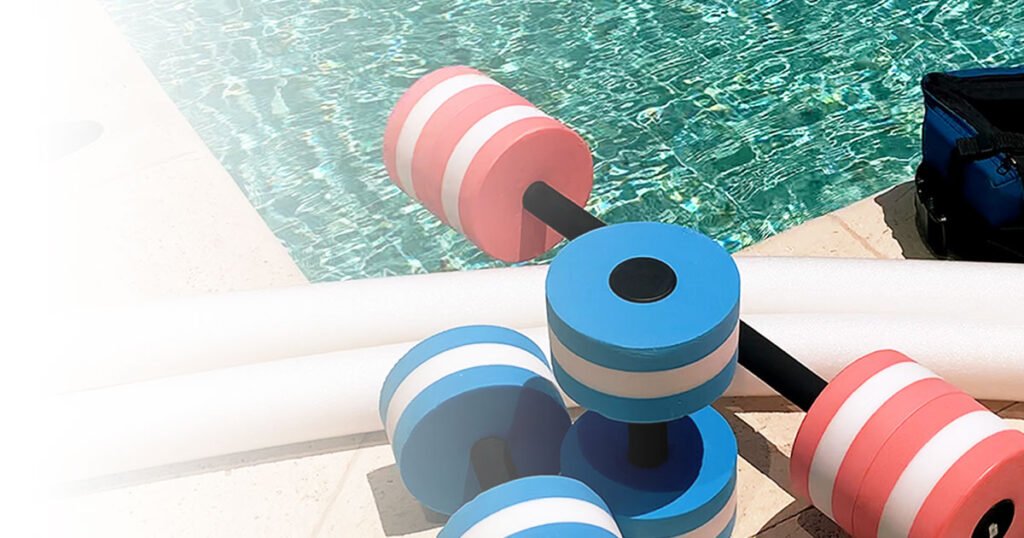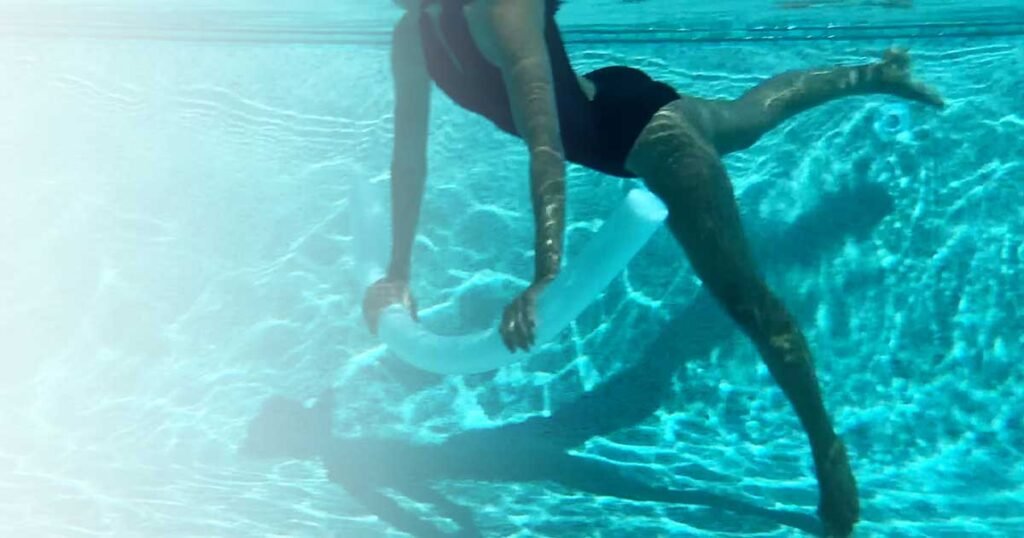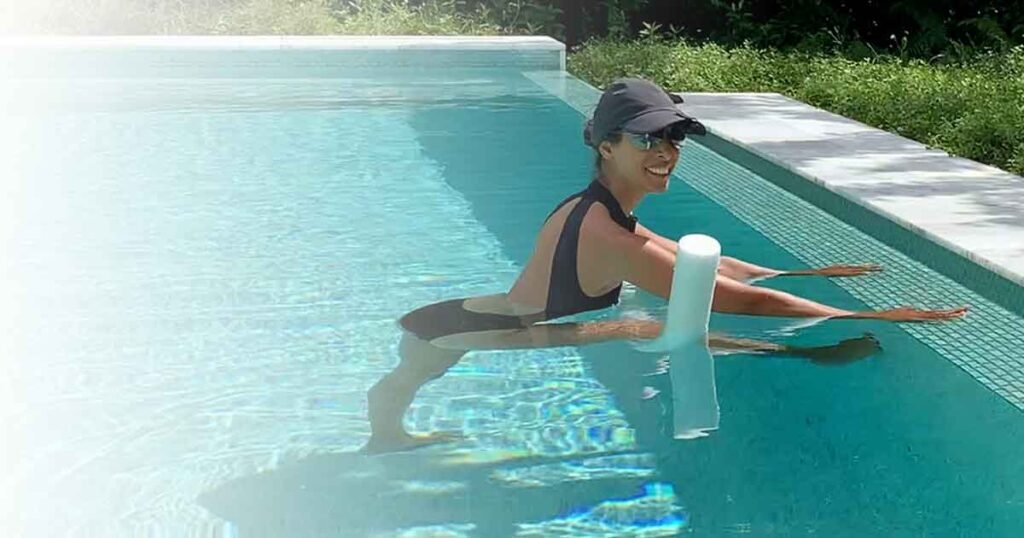Besides giving you more variety in your exercise routine, pool fitness equipment also gives you more deep-water options, more challenging resistance training, and more support in different physical positions.
The market offers a big variety of aquatic fitness equipment, but it all fits into one of these categories: Buoyant, Drag, Weighted, Rubberized and Floatation.
Here is a more in-depth description on each one of them and how to utilize it for your water workouts.
1. Buoyant Equipment, which is usually made of foam that floats, includes hand buoys, ankle cuffs, and foam logs or pool “noodles.” Some buoyant exercise gear, such as a beach ball, is filled with air.
- Buoyant equipment doesn’t weigh much on land, but you can use it to generate a lot of resistance in the pool. The bigger your prop is, the more resistance and muscle-load you’ll realize. If you pick very condensed foam, which provides more resistance in the water, you’ll get a more challenging workout.
- Buoyant equipment creates resistance when you move it toward the bottom of the pool and again when you work to control it on the way back up.
- Although buoyancy acts against gravity, with buoyant equipment, your muscle contractions in the water are similar to your muscle contractions in land-based exercise. In both cases, the targeted muscles contract concentrically and eccentrically, that is, contracting and shortening, and then contracting and lengthening.
- When you use floating apparatus, the same targeted muscles get a workout in both directions, up and down, resisting buoyancy when you move down toward the bottom and controlling your lift when you go up to the surface. You are then expending effort two ways: pushing down the buoyant gear and then slowing it as it rises. You push against its natural buoyancy until it rises right back to the surface and floats.
Let’s use our bicep curl example to show how using buoyant equipment changes an exercise and affects its purpose. Doing the same movements as in the bicep curl with buoyant equipment – like the noodle or hand buoys – makes this a great exercise for focusing on your triceps. When you press the noodle down and extend your elbows, your triceps contract and shorten (concentric movement). Then when you bend your elbow, slowing and controlling the natural upward buoyancy of the noodle, you continue to work your triceps, only now your muscles contract and lengthen (eccentric movement).

Hand Buoys
2. Drag Equipment is designed to increase the water’s drag force by increasing the surface area you’re working against and, therefore, creating greater resistance.
- You can use drag equipment by itself in shallow water exercise programs, and, if you combine it with buoyant or floatation equipment, you can use it in deep water, too.
- You’ll feel the water’s drag force even when you exercise without equipment, but you can enhance your muscle load and the muscle-value of your exercise by adding drag equipment.
- The amount of resistance you feel wearing a piece of drag equipment is based on its surface area and shape, how fast you move, and the water’s density and current or wave action. For example, aquatic webbed gloves increase the water resistance that your upper body encounters. They add more drag when you move your hands and arms underwater.
- You can comfortably use drag equipment for both cardio and strength exercises. However, keep in mind that the increased surface area and intensity that results from using drag gear can make it harder to use a full range of motion.
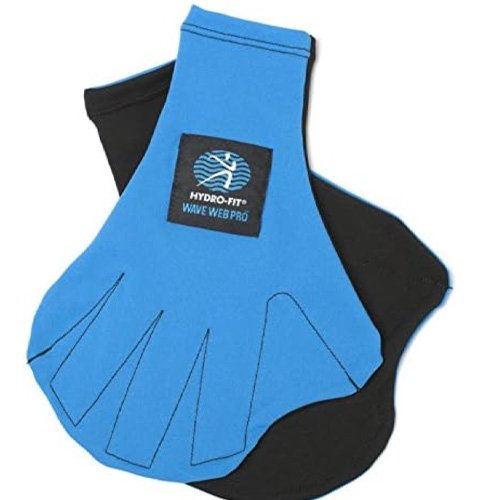
Hydro-Fit Webbed Gloves

AquaLogix Fins and Bells
Mor’s Inside Tip: when you use drag equipment in the water, keep your body aligned and do not strain your joints.
You can even use a simple frisbee plate to create more drag force and challenge your muscles in the pool. Click on the photo below to watch me demonstrating with the frisbee.
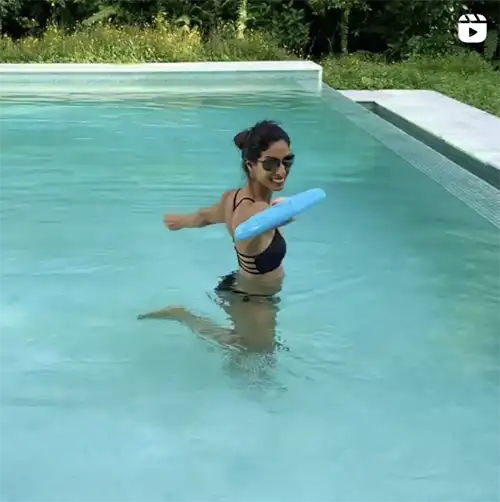
3. Weighted Equipment sinks in the water and provides resistance.
- As on land, gravity is the main factor determining how weighted gear – such as free weights or weighted ankle cuffs – will act, that is, if your weighted equipment is denser than water, which is usually the case.
- And although gravity plays a bigger role when you work with weighted gear, the properties of the water still contribute their magic. The water’s viscosity, buoyancy and drag force work with the weights to enable you to enhance your muscular strength and endurance and increase your lean body mass safely and effectively.
Mor’s Inside Tip: Weighted equipment is intended for shallow water use. Using it in deep water – which I do not recommend – requires experience and careful supervision and monitoring.
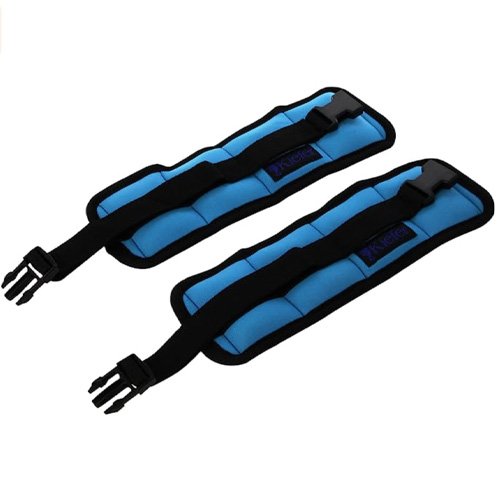
Kiefer Ankle Wrist Weights
4. Rubberized Equipment challenges your muscles. As on land, the amount of resistance you get depends on where you anchor your bands or tubes but, in the pool, you’re also working against the water’s drag.
- Rubberized equipment includes many types of bands and tubes with handles or straps. You have many choices of how to anchor the equipment to your body or to the pool ladder or barre.
- Although lots of land-based routines feature rubber resistance bands, some water exercises just don’t work on land. This is because the water supports you. In the water, you can perform postures you cannot replicate on land because gravity makes them impossible. Using rubberized pool equipment enables you to work your muscles for maximum impact without, for example, fear of falling.
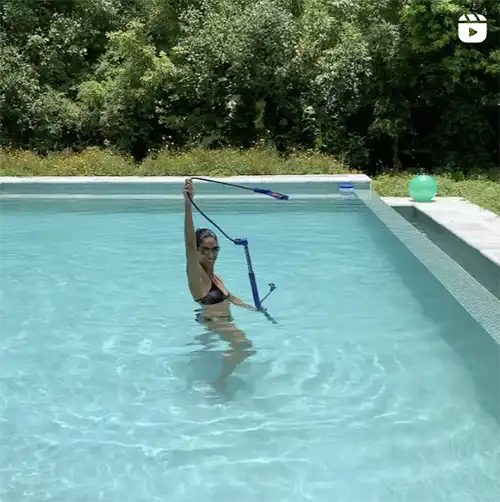
5. Floatation Equipment creates neutral buoyancy, rather than increasing resistance. For example, you might use a floatation belt in deep water to help you hold your body straight up and down with your head above the water line.
As discussed earlier in the Deep Water article, this easy vertical alignment lets you move your body freely, working against the water’s drag with a full range of motion and with zero joint compression. You can also use flotation belts that suspend or support your body for either relaxing or stretching in deep or shallow water. If you want to add resistance to your deep water workout, use flotation belts along with drag equipment, like webbed gloves or with fins that create drag on the hands or ankles.

Floatation Belt
Selecting and Purchasing Pool Exercise Equipment
You will want carefully chosen pool exercise equipment to add a mix of training options to your exercise routine, but before you spend your money, ask a few questions:
- What is the purpose of buying the pool exercise equipment?
- What will you use the equipment for?
- Do you need equipment to help you stretch, build stronger muscles, or support floatation?
- Are you seeking something that is specifically made to enable you to execute one particular exercise, or do you want a piece of equipment you can use to perform many exercises?
- Does the piece of equipment achieve your intended training goal?
Before you acquire something that seems popular or useful, be sure it’s tailored to your individual exercise objectives.
Mor’s Inside Tip: Based on my work with many different clients who do both aerobic and anaerobic exercise routines, I usually recommend starting with webbed gloves and a pool noodle or hand buoys. As your program advances, we can add other type of equipment, such as resistance bands, weights and ankle cuffs. I’m always glad to consult with you before you buy.
Pool Bottom and Wearing Shoes
The texture of the surface on the bottom of the pool doesn’t matter very much if you’re swimming or doing a deep-water workout. However, it can definitely affect your shallow-water workout.
If the pool bottom is rough, the skin on the soles of your feet can become abraded or even start to peel. If the pool bottom is slippery, performing your exercises will be very difficult – and not as safe or effective as you want – since part of exercising is being able to push against the bottom and use it as a leverage for jumping or changing directions. In this case, wear the appropriate water fitness shoes to give yourself extra traction and protection.
Fitness shoes provide extra shock absorbency, prevent slips (and injuries from slipping), protect the skin on the soles of your feet, and provide added weight and resistance. The right shoes can improve the quality of your workout by giving you better footing, a better grip, better vertical alignment, and more control when you move and change directions.
A good water shoe drains fast and has high breathability. This allows air circulation to your feet, helping them get dry faster. You don’t want a shoe that retains water for very long after you leave the water. Shop for water fitness shoes that are light, supportive, well-ventilated and durable.
Mor’s Inside Tip: Although I highly recommend wearing water shoes, exercising barefoot in the pool is definitely manageable, so if you forgot your water shoes don’t let that be the reason for not doing your aqua routine. Just be aware of the bottom surface (note if it’s slippery or rough), and take extra caution when barefoot, especially in an unfamiliar pool.
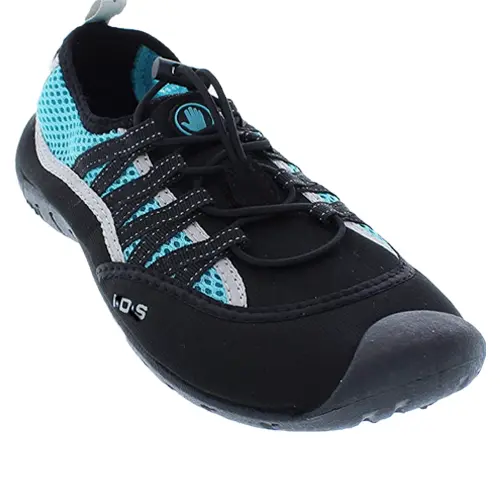
Water Aerobic Shoes
For on-demand water workouts – check out my YouTube channel Mor Movement

